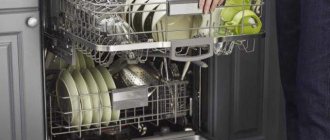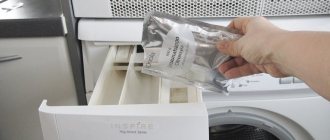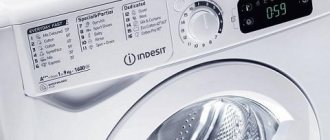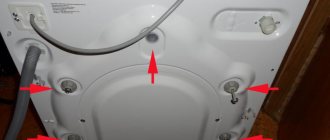The vast majority of modern dishwashers are equipped with a self-diagnosis system.
A kitchen “assistant” with a display, in case of problems with operation, displays a combination of letters and numbers. On units without a display, the indicator lights light up and flash in a specific order.
The self-diagnosis system allows smart kitchen appliances to:
- quickly identify the fault that has occurred,
- eliminate it or start a process that prevents more complex breakdowns,
- inform the owner about the problem.
It is impossible , and sometimes impossible, to ignore the appearance of an error code on the control panel of a dishwasher
If you leave the error unattended and simply reset it, you can expose yourself to considerable danger.
How to fix error E15 in a Bosch dishwasher
The uninterrupted operation of dishwashers (hereinafter also referred to as PMM, dishwashers) from German manufacturing companies is taken for granted by their owners.
But if one day an E15 error appears in a Bosch dishwasher, how to fix it? This event confuses many users of this technology. If error code E15 lights up on the display, do not rush to call a technician. Take the instructions for your dishwasher and read them carefully. Well-known German manufacturers - Bosch, Siemens, Neff - provide an explanation of the alphanumeric combinations that appear during malfunctions. And if you can’t find the instructions, check out our article.
Decoding error code E15
Modern dishwashers can diagnose their systems independently. If any breakdown occurs, the PMM displays a specific error code on the display. This solution allows specialists to fix defects faster without wasting time on diagnostics.
So, if there is an E15 error in a Bosch dishwasher and the faucet is on, this means that the Aquastop protective system has tripped. In this case, the dishwasher stops working. What is this system? It informs that water has leaked into the PMM pan.
Aquastop is simple and effective to use. The bottom of the PMM has a slope and a float is located in its lower part. As soon as water enters the pan, the float rises. As it rises, it puts pressure on the sensor, which triggers and transmits information to the control unit (hereinafter also referred to as the ECU) about the problem.
The ECU commands the safety valve built into the inlet hose to shut off the water supply (see diagram). At the same time, the drain pump (hereinafter also referred to as the pump) is turned on to pump out liquid from the dishwasher. This protection is so serious that it eliminates the possibility of flooding of the home.
There is an overflow of water
The water level sensor is responsible for the amount of water in the machine. If an overflow occurs, then most likely the sensor has become unusable.
In this case, the repair is inexpensive and quite simple - you can replace the sensor yourself by turning the dishwasher over (the sensor is located on the bottom).
One of the common failures of dishwashers is the lack of drainage.
Water is drained as follows: water passes through the pump into the hose and internal filter. Improper use may result in contamination of any of these parts. For some reason, the most common problem with this type of dishwasher is a Bosch dishwasher. This may be due to the fact that in the dishwasher market, Bosch is the undoubted leader. It was this manufacturer that won the trust of customers, which is why dishwashers of this particular brand are found in most homes.
Fixing a problem with pump contamination will be more difficult than a problem with injectors, but the essence is the same - you need to remove the pump, hose and internal filter and rinse them thoroughly.
Another reason for poor water drainage is that the drain hose is located too high.
Possible causes and their elimination
Error E15 in a Bosch dishwasher can appear for several reasons. It could be:
In addition to the problems that have already been listed, there may be another one - exceeding the recommended amount of detergent. This leads to excessive foaming and, as a result, the Aquastop protection is triggered. Let's look at how you can troubleshoot problems by repairing your dishwasher yourself.
Resetting your dishwasher
Resetting the settings is the first thing you need to do. It is quite possible that after rebooting the PMM, its functionality will be restored.
To do this you need to follow a number of simple steps:
If, after restarting, error E15 appears again, check the reset algorithm in the instructions supplied with the PMM. The fact is that many Bosch models have different reset algorithms.
For example, for some devices you need to do the following:
The manufacturer claims that in this way the ECU memory is completely cleared, which can bring positive results. Another universal option worth trying is to press the power button and hold it for 30 seconds.
Eliminating a stuck float
This operation is quite simple to perform. If you have a built-in unit, you will have to unplug it and carefully remove it from the furniture opening without damaging the inlet and outlet hoses.
Rock and move the unit, trying to cause the body to vibrate. Do not tilt it more than 30 degrees. After completing the rocking, tilt the body to the side at an angle of at least 45° so that water begins to flow out of the pan. Carefully drain it and leave the machine to dry for a day. Quite often this method turns out to be effective.
Removing blockages in the drain system
The most common mistake made by users is failure to promptly clean the filter from food debris, napkins and other foreign objects. In order to clean it, you need to remove the lower basket for dishes from the chamber. The filter is located at the bottom, next to the spray arm.
Usually, to remove it, it is enough to turn the glass 90°, but in older models of dishwashers, the filter may be removed differently. The mesh that frames the filter also needs to be removed. Wash it thoroughly together with the filter element using any detergent to remove grease.
If washing the filter does not produce the desired results, check the drain hose and drain for blockages. To remove the hose you will have to disassemble the machine.
Follow a series of simple steps:
Now you can disconnect the hose from the pump by loosening or removing the clamp and pulling it out. Check the hose for integrity and rinse under strong water. At the same time, you can check the pipes that are accessible inside the housing. Installing the hose on the seat and assembling the dishwasher is done in the reverse order.
Malfunction of the Aquastop system sensor and sprayer
These are the least likely causes of error E15. The sensor can be accessed by disassembling the housing. It is located in the glass along with the float of the Aquastop system. If the sensor malfunctions, it is best to replace it.
The nozzle rocker arms are located at the top and bottom of the chamber. Use a screwdriver to press the lock of each nozzle and remove them one by one. Purchase and install new parts.
In conclusion, I would like to note that most of the problems that arise during the operation of dishwashers can be resolved by owners on their own. All you need is desire. Well, if you are afraid of doing something wrong, call a specialist.
Video
We invite you to watch a video about why error E15 appears in a dishwasher and how to fix it:
Electronic engineer with many years of experience. For several years he was involved in organizing the repair of household appliances, including washing machines. Loves sport fishing, water tourism and travel.
Found a mistake? Select it and click the buttons:
In the 19th century, washing ladies' toilets took a lot of time. The dresses were first ripped open, and then each part was washed and dried separately so that the fabric did not become deformed. After washing, the clothes were sewn again.
Astronauts, while in Earth orbit, solve the problem of dirty things using an original method. Clothes are dropped from the spacecraft and burn up in the upper atmosphere.
For washing small items on the road or in a hotel, it is convenient to use a regular plastic bag. Socks or tights are kneaded inside a tied bag along with water and a small amount of detergent. This method allows you to pre-soak things and wash them without damaging the fabric or wasting a lot of powder and water.
The first officially patented washing machine was made of wood and was a box with a frame, half filled with wooden balls. Laundry for washing and detergent were loaded inside and the frame was moved using a lever, which, in turn, made the balls move and grind the laundry.
The expression “soap opera” (“soap”) did not arise by chance. The very first series and shows that had a female audience were broadcast on television at a time when housewives did cleaning, ironing and laundry. In addition, to attract female viewers to the screens, commercials for detergents: soaps and powders were often played on air.
History knows the fact that a kitten fell into the drum of a washing machine and, after going through a full wash cycle on the “Wool” program, got out of the unit unharmed. The only trouble for the pet was an allergy to washing powder.
There is a washing machine “for bachelors”. Linen washed in such a unit does not need to be ironed at all! The thing is that the device does not have a drum: some things can be placed inside the container directly on hangers (for example, jackets and shirts), and smaller things (for example, underwear and socks) can be placed on special shelves.
There are a variety of balls that are used in the washing machine. Antistatic ones will prevent the fabric from sticking to the body after washing, balls with special loops will “comb” the lint and prevent the appearance of pills, and silicone ones with pimples will prevent fluff from matting when washing outerwear.
Washing machines equipped with the “No Iron” or “Easy Iron” functions can wash clothes with little to no wrinkling. This effect is achieved through a special approach to spinning - it is performed at low speeds, with long pauses, and a small amount of water is retained in the tank.
Source
Errors in the dishwasher. How to reset error codes in the dishwasher
Built-in Bosch dishwasher (Bosch SMV40E10EU)
How to reset errors in your dishwasher.
Resetting error codes in a Bosch dishwasher. Resetting errors in a Bosch dishwasher (Bosch SMV40E10EU)
Instructions for resetting errors in a Bosch dishwasher
So, if too many errors have accumulated during the operation of your Bosch dishwasher, you can reset them in a special way by pressing the buttons. If there are a large number of accumulated errors (lack of water, motor starting, etc.), the dishwasher may begin to “glitch” and may not start the first time.
So, press the following combinations of buttons on the Bosch dishwasher to reset the errors:
Open the dishwasher door. Let's turn it on. Press program buttons 1+3 simultaneously (hold for 3 seconds). We close the door. Open the dishwasher door. Turn off the dishwasher. Then we turn it on. Press the reset button (hold for 3 seconds). We close the door. And we wait for the end-of-wash signal from the dishwasher. After the signal, open the door. Turn off the car. Your dishwasher has cleared error codes and rebooted.
Sometimes the dishwasher works, sometimes it doesn’t. And it periodically writes that there is no water supply, but the blades and filters are cleaned and the water supply tap is not turned off and there is water, then the reason for the “glitches” of the dishwasher may be a pump failure. It is difficult to determine such a breakdown and replacing the pump is expensive (the total cost of calling a dishwasher repair technician and the repair itself can be 5-8 thousand rubles). In this case, consider whether it would be more profitable to buy an inexpensive new dishwasher. For example, the price of a Bosch SMV40E10EU dishwasher was about 25,000 rubles; repairing it cost 8,000 rubles. And a new built-in dishwasher for 12-13 sets of dishes from a not so well-known brand can be bought for 10-13,000 rubles.
1. It is unclear what programs 1 and 3 are for the Bosch dishwasher. There are buttons on the left from top to bottom: pan, auto, eco; there are 3 more buttons on the right. Which of them are programs 1 and 3 is unclear. But no matter what buttons you press at the same time, only 2:30 blinks (auto program). 2. The reset button does not complete the washing cycle when the door is open, and the same does not complete the next time it is closed. 3. Accordingly, E23 is not reset, and your instructions are complete crap.
These instructions are from a dishwasher repairman. Using the Bosch SMV40E10EU machine as an example. In the photo at the top of the article you can see the buttons from left to right - button 1 is the leftmost button. Button 3 is the third button from the left. This instruction helped me reset the error in the dishwasher several times when it started to malfunction.
I managed to reset it like this. Opened it, turned it on, pressed 2 Reset buttons (1 and 3) until 0 appeared on the display, released it, closed it. The machine started working (pumping out water). He waited until the signal for the end of the program sounded, opened the door, and turned it off. All! Now the machine started working.
Source
The washing program does not start. The machine does not turn off
In some situations, the dishwasher may not respond to commands or other user actions after being turned on. At the same time, it is not even possible to turn off the machine by pressing the corresponding button.
All this indicates that the control panel is faulty. The most likely is that a problem has been detected with the button contacts or with one of the control triacs. There is no need to rush to call a professional, because in most cases, you can solve the problem yourself.
In order to check and replace a triac, the user will need basic knowledge of the operating principle of semiconductor circuits, as well as the ability to use a multimeter and a soldering iron. Those who want to carry out repairs on the dishwasher with their own hands can do this according to the following list of actions:
- Setting up the multimeter. The device is turned on and set to voltmeter mode, then the minimum value in volts is set. Next, the multimeter probes are connected to each other, and the operation of the device is checked.
- Removing the control board. After turning off the power to the dishwasher, open its door. There are fasteners at the ends and on the inside that need to be unscrewed. The inside of the door can then be removed to reveal the desired control board.
- Repairing the control board. Having found the required triacs on the control board, you need to check their serviceability one by one with a multimeter. Once a faulty component is detected, it will need to be unsoldered and removed. Taking the extracted part as a sample, you should purchase a similar one for subsequent replacement.
- Soldering. Carefully, so as not to damage the tracks, you need to solder a new part to replace the old one.
For those who perform such an operation for the first time, you should refer to the photo above, where the arrow indicates one of the triacs.
Dishwasher refuses to turn on
When the device does not want to turn on, and you have correctly connected it to the water and electricity supply systems, the source of the problem may lie in the electrical network. First, you should check the serviceability of the outlet and power cord . In addition, it would be a good idea to check whether the equipment is powered correctly, based on the requirements of the operating instructions.
We check at the very beginning and if the PM does not start working
Many malfunctions of dishwashers are explained by simple reasons - a drop in voltage in the network, insufficient water pressure, clogged filters, etc. At the very beginning, after we have discovered that the dishwasher is not working or is working abnormally, we check:
What to do when an error code appears
When an error code appears, you need to refer to the instructions for the dishwasher to find its explanation and understand what the reason is and what exactly is wrong with the unit.
Contact VseRemont24 if:
Dishwasher malfunctions can be minor and can be fixed within a couple of minutes, but most of them require complex repairs.
Any external or internal part, as well as the entire unit of the dishwasher, can fail.
Failures of important components lead to the most common malfunctions:
A faulty dishwasher works worse and does not wash dishes well. From a technology that saves water and electricity, it turns into an expensive “pleasure”. What is most important is that using a faulty electrical appliance is unsafe for people’s health and lives!
How to reset all Bosch dishwasher errors
One of the most popular in our country, the German manufacturer of household appliances Bosch, has provided for immediately resetting all previously accumulated errors in its units.
To reset the accumulated errors of the Bosch dishwasher and reboot it completely, you need to:
If you doubt the correctness of the actions taken, and do not want to once again expose yourself and the equipment that is irreplaceable in everyday life to risks, contact VseRemont24!
A certified technician will repair a dishwasher of any make and model, no matter what kind of damage occurs to it!
Reason #1: Electronics failure
Not only the human brain, but also the electronic brain also needs to rest sometimes. It’s not very helpful that this “sometimes” happened in the middle of the wash cycle, but it doesn’t matter. You can try turning the dishwasher off and on again. This often helps return the dishwasher cycle to normal.
Program crash
There are times when a simple malfunction occurs in the operation of equipment. To solve this problem, it is often enough to turn the power off and on. You can try changing the washing program or resetting the settings to factory settings (the reset algorithm is usually specified in the instructions for the device).
Washing and drying modes
The operation phases of the device vary and depend on additional options, but on average they take 0.5 to 2.5 hours. Using some short cycles can save time and reduce resource consumption.
| Mode | Peculiarities | Nuances |
| Main wash | 2-3 hours in water at about 600C. | The VarioSpeed option reduces the period to 78 minutes. |
| Fast cycle | Lasts 33-40 minutes | Cleaning lightly soiled devices. |
| Super wash (intensive program) | 84 min at t 60-700С | Intensive washing of contaminants. |
| Soaking | 95 minutes in water with temperatures reaching 700 C | Designed for dried or burnt dishes and utensils. |
| Economical (daily program) | 170 min at t 500C | Can be reduced to 80 minutes. |
| Rinse (fast program) | 15 minutes | Used before the main wash. |
| Delicate wash | 110 min at t 450C | Designed for fragile materials. |
Program for intelligent recognition of the degree of pollution and workload. Automatically switches on the most suitable mode.
The presence of the IntensiveZone option allows you to create a special washout zone where a larger volume of hot water flows.
The turbo drying mode makes it possible to speed up the drying process.
Reason #2: filter clogged
You, of course, do not forget to remove food residues from the dishes and use special detergents. But the filter still gets clogged over time. And now, apparently, the pump simply cannot push waste water through it, and that is precisely why the machine does not stop. Wash the filter, and if it breaks, replace it.
Faulty water supply and drain hose
If a breakdown occurs, be sure to check the integrity of the water supply and drain hoses. There are situations when the hose becomes bent and water hardly flows through it into the machine or even goes down the drain.
Filter problem
If you do not wash the filter in time and food remains are stuck in the machine, the pump may not be able to cope with the task of pumping out water, thereby causing a breakdown. The same situation can arise if the plastic structure of the filter breaks.
This problem will be solved by simply cleaning the filter and possibly replacing it (in the event of a structural failure).
Reason No. 4: pump failure
If there are no obstacles in the way of waste water, then perhaps the obstacle is weakened pump power. Most often, in this case, the machine stops completely and does not drain the water. But this is if the pump is completely broken. As long as there are remnants of its former power - in the sense of power - the pump will try to pump out water, and these attempts can be endless. In order to be sure of the diagnosis, you should call a dishwasher repair specialist who will tell you whether it’s worth changing the pump or something else.
Sensor failure
It is possible that the dishwasher does not turn off due to a broken water level sensor and needs to be replaced. You can make the replacement yourself, or contact a household appliance repair specialist.
There is an overflow of water
The water level sensor is responsible for the amount of water in the machine. If an overflow occurs, then most likely the sensor has become unusable.
In this case, the repair is inexpensive and quite simple - you can replace the sensor yourself by turning the dishwasher over (the sensor is located on the bottom).
One of the common failures of dishwashers is the lack of drainage.
Water is drained as follows: water passes through the pump into the hose and internal filter. Improper use may result in contamination of any of these parts. For some reason, the most common problem with this type of dishwasher is a Bosch dishwasher. This may be due to the fact that in the dishwasher market, Bosch is the undoubted leader. It was this manufacturer that won the trust of customers, which is why dishwashers of this particular brand are found in most homes.
Fixing a problem with pump contamination will be more difficult than a problem with injectors, but the essence is the same - you need to remove the pump, hose and internal filter and rinse them thoroughly.
Another reason for poor water drainage is that the drain hose is located too high.
Reason No. 5: automatic leakage protection triggered
Automatic protection against leaks in a dishwasher is a float at the bottom, which, when excess water gets in, opens the damper and the water goes down the drain.
The water leaves, the damper opens, and the water flows again and the damper opens again. This can continue indefinitely in the literal sense of the word. And your search for the location of the leak can also continue indefinitely, just like attempts to remove water from the pan with a rag in the hope that everything will work out.
This may give a temporary effect, but we are unlikely to talk about the normal operation of the dishwasher. At least until you call an experienced technician who will find the leak and the reason for the automatic protection.
These are the top five most common reasons why your dishwasher may not want to turn off at the end of a wash cycle. Although, who knows, behind a closed door you can’t see how well she washed the dishes this time and whether she washed them at all.
For example, if the reason for non-stop operation is the activation of automatic leakage protection, then the accumulated water leaves before it has time to soak and properly wash the dishes loaded into the washing compartment.
A professional master will save you in any case
In general, continuous operation may not be the only surprise that an overly industrious dishwasher will present. To avoid such surprises in the future, contact ALM-remont.
Our technicians will check the functionality of all components and mechanisms, find and eliminate the true cause of problems in the operation of the machine. And your dishwasher will work for a long time - in the good sense of the word!
Internal faults
If all of the above faults are excluded, most likely the problem lies inside the machine. In this case, to determine the malfunction and eliminate it, it is necessary to carry out a number of actions:
If, after carrying out all the above-described manipulations, the breakdown has not been identified, you must contact the service center. Specialists will be able to quickly identify the cause of the malfunction and eliminate it.
Rules for loading dishes
Depending on the model, the equipment washes from 4 to 12 sets of dishes at a time. A number of additional options make the download process easier. For example, with Rackmatic you can adjust the position of the upper basket.
| Basket | Upper | Lower | Removable | Additional |
| Purpose | Mugs, small dishes | Large dishes, kitchen utensils. | Cutlery: knives, spoons, forks and others. | Allows more efficient use of internal space. |
| Nuances | Glasses and mugs are turned vertically upside down. Wine glasses and glasses are placed in the holder. On the left is a removable rack for small bowls. They are placed without leaning against each other. | Plates with a height of more than 30 cm. In some models, this compartment is transformable. When loading, pans are placed vertically, pots - upside down. | Sharp objects are placed vertically with the point down. | Not available on all models. The five-centimeter depth allows you to place coffee cups, cutlery and other small utensils. |
When placing dishes in trays, you need to remember that overloading the basket can cause the machine to tip over.
What to do if the device turns off 1 minute after startup
In situations where the dishwasher started, worked for 1 minute, signaled the end of the cycle and turned off, many owners believe that the program has gone wrong. This often happens during continuous operation of the device, several years of operation. After restarting, the machine can repeat the process again or work in normal mode and “make a mistake” during one of the subsequent washes.
Often, this situation occurs due to problems with water drainage when the drain hose becomes bent. If, when you open the dishwasher door, there is no water inside, the cause of the breakdown should be looked for in the drainage system, circulation pump, or control unit malfunction.
The only solution to the problem is to buy a new circulation pump. Each dishwasher has its own model of this part. You can install it yourself or use the services of service center technicians. Solving the problem of a faulty control unit should only be entrusted to specialists.
Incorrect temperature
Many dishwasher manufacturers, such as Bosch and Indesit, install a choice of temperature settings on their devices - from 30 to 90 degrees. If you set a certain temperature, but get a clearly inappropriate result, then there may be problems with the temperature sensor:
- The sensor came out of position;
- Water is supplied to the system under insufficient pressure (during repair work on the water supply line);
- The heater has failed.
It is best to entrust the repair of such a breakdown to an experienced technician at a service center.
The machine stops mid-cycle
The situation when the dishwasher fills with water and stops is the most common “disease” of these units. It develops as a result of a blockage that has formed inside or outside the dishwasher. How can you tell if the blockage is outside? Watch the water drain from the kitchen sink. If it’s bad and slow, you need to clean the siphon, manually or using special abrasives. Do not forget about safety precautions when handling the latter.
Inside the machine, food debris that gets into the drain system can clog:
To carry out self-cleaning, you must do the following:
Incorrect temperature
Many dishwasher manufacturers, such as Bosch and Indesit, install a choice of temperature settings on their devices - from 30 to 90 degrees. If you set a certain temperature, but get a clearly inappropriate result, then there may be problems with the temperature sensor:
- The sensor came out of position;
- Water is supplied to the system under insufficient pressure (during repair work on the water supply line);
- The heater has failed.











